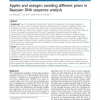Free Online Productivity Tools
i2Speak
i2Symbol
i2OCR
iTex2Img
iWeb2Print
iWeb2Shot
i2Type
iPdf2Split
iPdf2Merge
i2Bopomofo
i2Arabic
i2Style
i2Image
i2PDF
iLatex2Rtf
Sci2ools
BMCBI
2010
2010
Apples and oranges: avoiding different priors in Bayesian DNA sequence analysis
Background: One of the challenges of bioinformatics remains the recognition of short signal sequences in genomic DNA such as donor or acceptor splice sites, splicing enhancers or silencers, translation initiation sites, transcription start sites, transcription factor binding sites, nucleosome binding sites, miRNA binding sites, or insulator binding sites. During the last decade, a wealth of algorithms for the recognition of such DNA sequences has been developed and compared with the goal of improving their performance and to deepen our understanding of the underlying cellular processes. Most of these algorithms are based on statistical models belonging to the family of Markov random fields such as position weight matrix models, weight array matrix models, Markov models of higher order, or moral Bayesian networks. While in many comparative studies different learning principles or different statistical models have been compared, the influence of choosing different prior distributions fo...
| Added | 08 Dec 2010 |
| Updated | 08 Dec 2010 |
| Type | Journal |
| Year | 2010 |
| Where | BMCBI |
| Authors | Jens Keilwagen, Jan Grau, Stefan Posch, Ivo Grosse |
Comments (0)

